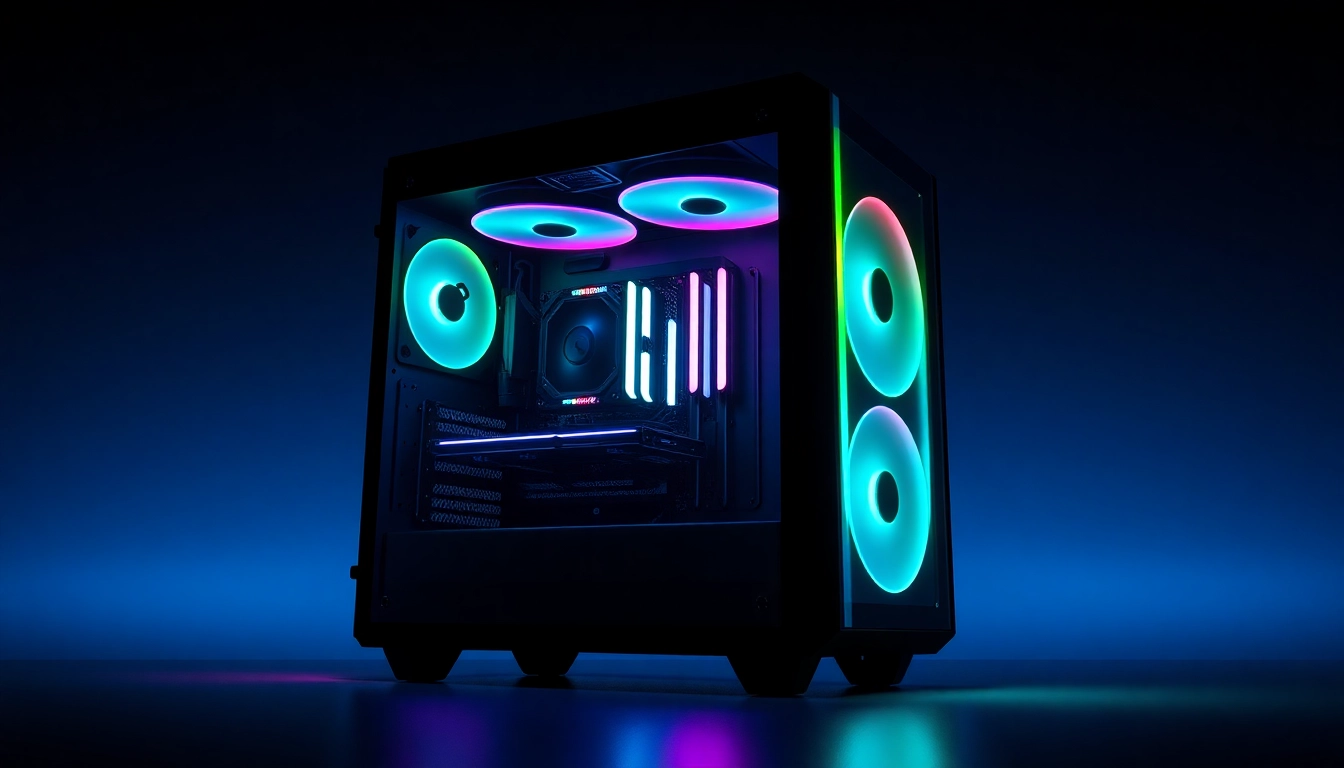
Understanding Gaming PC Cases
What is a Gaming PC Case?
A gaming PC case serves as the shell for your computer components, housing crucial parts such as the motherboard, CPU, graphics card, power supply, and storage drives. Unlike standard computer cases, gaming PC cases are specifically designed with features that optimize performance, aesthetics, and cooling capabilities tailored for gaming. The choice of a gaming PC case influences overall airflow, cable management, and installation ease, making it a vital component for any gaming setup.
Importance of Choosing the Right Case
Selecting the right gaming pc case is crucial for several reasons. First, it affects the cooling efficiency of your components, as poor airflow can lead to overheating and reduced performance. Second, a well-designed case can improve the aesthetics of your gaming setup, creating an immersive environment. Lastly, the case must be compatible with your existing components, ensuring easy installation and future upgrades.
Key Features to Look For
When choosing a gaming PC case, consider the following key features:
- Airflow and Cooling: Look for cases with multiple fan mounts and support for liquid cooling systems.
- Size and Compatibility: Ensure the case can accommodate your motherboard size (ATX, Micro-ATX, or Mini-ITX) and graphics cards.
- Build Quality: A sturdy metal frame and tempered glass panels enhance durability and aesthetics.
- Cable Management: Features like tie-down points, routing holes, and modular designs simplify the building process and maintain a tidy appearance.
- Expansion Options: Verify that there are ample drive bays and expansion slots for future upgrades.
Types of Gaming PC Cases
Mid-Tower vs. Full-Tower Cases
Mid-tower and full-tower cases are two of the most common types used in gaming builds. Mid-tower cases typically provide a balance between size and expandability, making them ideal for users who want a good amount of space without overwhelming their setup. They usually accommodate standard ATX motherboards and several expansion slots.
On the other hand, full-tower cases offer much more space, allowing for extensive cooling solutions and multiple GPUs. They are perfect for high-end gaming rigs that demand more power and cooling efficiency. Understanding the differences in size and capability between these two types can help you make an informed choice based on your gaming needs.
Form Factors: ATX, Micro-ATX, and Mini-ITX
Form factors dictate the size and layout of motherboards and, consequently, the case you will choose:
- ATX: Standard for most gaming setups, allowing multiple expansion slots and better cooling options.
- Micro-ATX: A more compact version of ATX that still offers decent expansion capabilities but may have limited space for airflow.
- Mini-ITX: Ideal for ultra-compact builds, often used for small form factor PCs, focusing more on portability than expandability.
Specialty Cases: Custom Built and Unique Designs
For gamers seeking to make a unique statement, custom-built cases offer the ultimate personalization. These cases can be designed from scratch or modified to include specific elements like elaborate themes, built-in lighting, or unique cooling solutions. There are also many niche brands that focus on aesthetic cases, merging functionality with art to create eye-catching setups that are sure to impress.
Cooling Solutions in Gaming PC Cases
Importance of Proper Cooling
When gaming, high-performance components generate significant heat. Proper cooling is essential to maintain performance and prolong hardware lifespan. An inadequately cooled system can lead to thermal throttling, where the CPU or GPU reduces performance to prevent overheating. This can noticeably decrease gaming performance, making effective cooling solutions critical.
Airflow Design Features
Good airflow design in a case is paramount to ensure that cool air can flow in while warm air is expelled efficiently. Look for cases that provide:
- Intake and Exhaust Fans: Cases with multiple fan placements can create a very effective airflow layout.
- Mesh Front Panels: These allow unhindered airflow while keeping dust out.
- Positive Pressure Design: This method uses more intake than exhaust fans to prevent dust buildup and negate overheating.
Liquid Cooling Compatibility
For those with high-performance builds, liquid cooling is often a preferred method due to its efficiency in heat dissipation. When selecting a gaming PC case, ensure it supports the size and type of the liquid cooling system you plan to use, whether it be AIO coolers or custom loops. Not all cases can accommodate radiators, reservoirs, and pumps, thus ensuring compatibility is critical.
Popular Gaming PC Case Brands
Leading Brands Overview
Several brands dominate the gaming PC case market, known for quality, innovative designs, and reliability. Some of the leading brands include:
- Corsair: Renowned for their RGB lighting and exceptional build quality.
- NZXT: Famous for sleek designs and user-friendly features, catering to both looks and functionality.
- Fractal Design: Focuses on minimalist aesthetics without compromising on performance.
- Thermaltake: Known for customizable options and extensive cooling solutions.
Top Models and Their Features
Here are a few standout models from popular brands:
- Corsair 4000D Airflow: Excellent airflow with a balanced design and plenty of space for upgrades.
- NZXT H510: A beautiful ATX mid-tower that simplifies cable management with pre-installed channels.
- Fractal Design Meshify C: Focused on airflow and cooling, featuring a mesh front panel.
- Thermaltake View 71: Offers tempered glass panels for showcasing internal components and RGB lighting.
Brand Comparisons Based on User Reviews
User reviews are an invaluable resource for understanding real-life performance and satisfaction with a case. For instance, Corsair cases are highly rated for their build quality and cooling capabilities, while NZXT is celebrated for ease of assembly and aesthetic appeal. Reviewing feedback on platforms such as Reddit or dedicated tech forums can provide insight into how these brands and models perform over time.
How to Build Your Gaming PC with the Right Case
Step-by-Step Case Setup Guide
Building your gaming PC involves several critical steps, from selecting the right components to assembling them inside your chosen case. Here’s a condensed step-by-step guide:
- Prepare Your Workspace: Ensure you have a clean, static-free environment with adequate lighting.
- Gather Your Components: Collect your motherboard, CPU, GPU, RAM, power supply, and storage.
- Install the Power Supply and Fans: First, install the PSU to ensure it doesn’t obstruct other components. If your case has pre-installed fans, check orientation for optimal airflow.
- Insert the Motherboard: Carefully place the motherboard onto the standoffs in the case and secure it with screws.
- Install the GPU: Slot the GPU into the appropriate PCIe slot on the motherboard, securing it as necessary.
- Attach Storage Drives: Mount your SSDs or HDDs in their respective bays; consult the case manual for the best method.
- Connect Cables: Organize and route cables to maintain a neat appearance while ensuring all connections are secure.
- Test the Build: Before closing the case, power the system to ensure all components function properly.
- Close It Up: Attach the case’s side panels once testing is complete, and tidy up cables as needed.
Common Mistakes to Avoid
Several common mistakes can complicate the build process or lead to performance issues:
- Ignoring Compatibility: Ensure all components fit the case and work together before purchasing.
- Poor Cable Management: Don’t overlook routing and securing cables; good cable management contributes to airflow.
- Forgetting Cooling Solutions: Do not neglect cooling; always consider sufficient airflow and cooling solutions for your components.
Enhancing Aesthetics and Functionality
Improving the look of your case doesn’t just make it more visually appealing; it can also enhance cooling and usability. Consider adding RGB lighting strips, cable sleeves, or even custom fans for a personal touch. You can also invest in magnetic dust filters to maintain cleanliness while ensuring airflow isn’t hampered.






